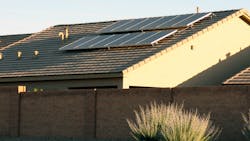Last month I was very efficient with my time management and got all my work completed more than a week ahead of my deadlines. That meant I had some extra time on my hands, which gave me a chance to catch up on my reading and get some chores done. The first order of the day was running some errands, but as luck would have it, I got distracted by something going on down the street.
There were three trucks parked in front of a neighbor’s house. Each was wrapped in colorful advertising proclaiming now is the time for adding solar to your roof. The yard was cluttered with boxes, mounting brackets, reels of cable, and miscellaneous odds-and-ends hardware. My neighbor had signed up for rooftop photovoltaic (PV) panels. This isn’t the first house in the neighborhood to get PV panels installed, and if the surveys are correct it will not be the last.
All this activity got me thinking about how many homes in the area have added rooftop solar panels in the past year. The downside of each installation is the influx of solar hucksters going door to door peddling solar deals. They must be fairly successful judging by the growing number of solar panels popping up on roofs. That switched my thinking from chores to some papers I had put off reading.
My first technical paper was a disturbing study about utility-scale wind farms and solar ranches being dangerous to the environment. The uptake was utility-scale renewables take up too much space. Space that is needed for necessities other than electricity. It was a real gloom and doom scenario, but the authors had painted themselves in a corner.
They had not taken into account that technologies are not static. In the 1990s we saw wind turbines were rated about 750 kWs (kilowatts), but today turbines are pushing 20 MWs (megawatts). On the solar side, the efficiency of today’s monocrystalline PV panels are increasing too. Modern panels efficiency are over 20%, whereas early panels’ efficiency were in the single digits.
Untapped Resources
My next paper serendipitously answered the first. This one from the University of Cork in Ireland provided a different perspective on rooftop solar. Their paper said, “They did a high-resolution global assessment of rooftop solar photovoltaics potential using big data, machine learning and geospatial analysis of global rooftops.” I was hooked, these are some of my favorite tech-toys!
In one section, the authors reported they had done a global calculation of all the existing rooftop areas. Because of space, I zeroed in on the portion focused on the U.S. rooftops. The folks at Cork determined that if all the rooftop area had PV panels installed on it, the output would be sufficient to match the current U.S.’s total electricity generation. The installed behind-the-meter (BTM) solar is breaking records every year, and it will be interesting to watch what happens.
Economics Factor
Of course the sun doesn’t shine 365/24/7, so it’s going to require energy storage. That too is increasing BTM, but it’s expensive. A report published by Lawrence Berkley National Lab (LBNL) last year pointed out cost doesn’t appear to matter to the customer. Researchers found that residential batteries didn’t make sense economically, but residential battery installations are increasing. LBNL said customers installing batteries were driven by considerations other than economic such as resilience associated with backup power.
LBNL noted that in 2020 about 550 MWs of the installed storage was paired with solar. Going deeper, Berkley looked at four locations in the US, and compiled a standard configuration for solar-plus-storage. LBNL said it was “7 kW PV paired with 5kW/10 kWh battery storage, which could serve, on average 60%-80% of a typical customers’ daily consumption over the course of a year.”
Because I’m an engineer, I made a spreadsheet with my home’s monthly/yearly power consumption. Then I calculated rooftop PV alone, and PV-plus-storage. I went to my utility’s webpage to see what the incentives they offered for various solar programs. Based on what I found, it turned out I would be better off keeping the solar-plus-storage and using it to reduce my monthly electric bill. I’d save money on electricity, and I’d have backup in the event of power outages.
I’m not ready to run out and have PV installed yet, but I’m ready when someone rings the doorbell to sell me solar. Plus I learned a lot about the economics of the BTM solar marketplace.
About the Author
Gene Wolf
Technical Editor
Gene Wolf has been designing and building substations and other high technology facilities for over 32 years. He received his BSEE from Wichita State University. He received his MSEE from New Mexico State University. He is a registered professional engineer in the states of California and New Mexico. He started his career as a substation engineer for Kansas Gas and Electric, retired as the Principal Engineer of Stations for Public Service Company of New Mexico recently, and founded Lone Wolf Engineering, LLC an engineering consulting company.
Gene is widely recognized as a technical leader in the electric power industry. Gene is a fellow of the IEEE. He is the former Chairman of the IEEE PES T&D Committee. He has held the position of the Chairman of the HVDC & FACTS Subcommittee and membership in many T&D working groups. Gene is also active in renewable energy. He sponsored the formation of the “Integration of Renewable Energy into the Transmission & Distribution Grids” subcommittee and the “Intelligent Grid Transmission and Distribution” subcommittee within the Transmission and Distribution committee.
